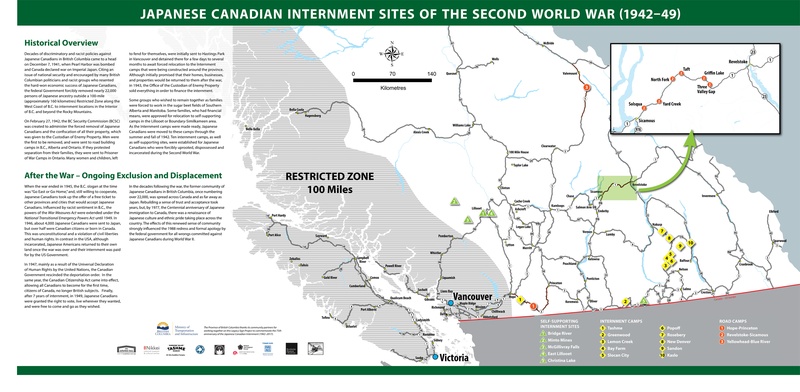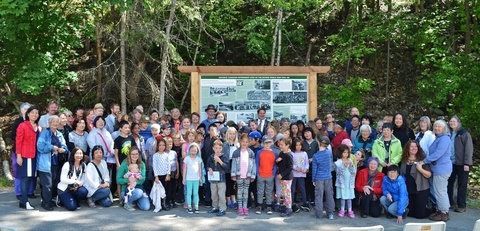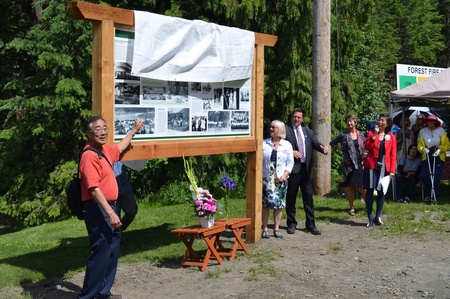Can you tell us a bit about each of the sign sites? What was the local community support like?
It began on October 2017 at Tashme Internment Camp - located beside Sunshine Valley Tashme Museum with a stop of interest sign about thirteen km outside Hope on Highway 3.
On May 2018, a stop of interest sign was installed for the Lillooet self-supporting sites: Bridge River, Minto, McGillvray Falls, East Lillooet, Taylor Lake with East Lillooet.
Our committee partnered with the District of Lillooet (town government) to make the Japanese Canadian Internment Memorial Garden where the sign is located. Located on Highway 12 at the actual internment camp overlooking the Fraser River. The Lillooet Seniors’ Committee, comprised of original Internees from East Lillooet led by Dr. Aki Horii. Also, a beautiful stone monument in the Memorial Garden was erected as a tribute to the Issei who overcame the hardships of the internment.
In June 2018. Slocan Extension (includes Lemon Creek, Slocan City, Bayfarm & Popoff sites). The sign is located on Highway 6 at a pull-out at the entrance to Slocan City, close to Lemon Creek. Another one was unveiled at the New Denver Internment Camp site, located on a pull-out on Highway 6, a few blocks from New Denver Internment Memorial Centre.
A fifth one was unveiled later in June to mark Kaslo Internment Camp site, located on Highway 31, at the entrance to Kaslo town before the bridge. In July, the Greenwood Internment Camp site was unveiled, located in Nikkei Legacy Park on Highway 3.
Number seven, marking the Hope-Princeton Road Camp, was launched in September at the pull-out on Highway 3 just before Sunshine Valley and Tashme Internment Camp sign. Finally, also in September, a sign marking the Revelstoke-Sicamous Road Camp, located at the pull-out at Three Valley Gap Highway 1. (BC Parks and the National Association of Japanese Canadians (NAJC) in July 2018 installed a stop of interest sign on the Yellowhead-Blue River Highway near the Mount Robson Visitor Centre.)
Local community support was tremendous at each of the sign unveilings and we could not have pulled off these events without the leadership of each of those local communities. Every sign unveiling event was well attended by local residents, and we got extensive local media coverage at every sign unveiling event. We were also able to have local schools attend this historic event. Also, we were able to celebrate that we could acknowledge our history together.
Any particular stories about the 2018 impact on those areas that you can share?
The true legacy of this project is that the local communities now feel the internment history that happened in their backyard is now their history. Countless times, many of the local teachers, residents, and schoolchildren said they didn’t know about the internment, let alone knowing that it happened right in their own towns. One high school student said when interviewed by the CTV television reporter, “When I grow up and become an adult, I don’t want to make these same mistakes.”
Looking at the project as a whole, what is your lasting hope as a Nikkei?
My greatest hope is that Japanese Canadian history and its lessons about racial discrimination and social injustice be taught in the schools so that the younger generations will learn the lessons of the past to not repeat them. It’s our job to relate the lessons of our past to what’s happening in today’s society.
What exactly did the JCs build? What exactly did JCs do there?
As forced labour, Japanese Canadian men were instrumental in building Highway 1 (Revelstoke-Sicamous Highway), Highway 3 (between Hope and Princeton), and the Yellowhead-Blue River Highway. They were mainly used for manual labour for dirty, treacherous work to clear and widen the roads.
How long were the camps in operation? Who exactly were enlisted?
The road camps were in operation from 1942-1945. Able-bodied Japanese Canadian men aged eighteen to fourty-five years old were forced to work to build the roads.
Do you have any idea about the number of survivors?
In total, there were approximately 1800 men enlisted as forced labour.
How did these highways change Canada?
Of course, highways connect people and goods. The highways facilitated the increase of people and goods, becoming major arteries of transport.
Any final reflections about the project and what still might be needed to be done moving forward?
The next step is for the sign content to be uploaded onto Heritage BC’s Historic Site map so that the public and educators and school children have access to the history. We are hoping to create a legacy booklet that contains all the signs as a teacher training tool for educating our history. As a descendant of the internment, I now have a visceral and physical sense, by being at the actual sites, what my ancestors experienced, their hardships, their joys, and their tribulations. I also feel a deep sense of rootedness now to the land of BC and how privileged a life we were given. This gratitude is also anchored with the responsibility to continue to educate the lessons of history to ensure we do not take what we have for granted.
Any message to the survivors and their families in particular?
I encourage all descendants to do the tour of the signs and to visit the actual sites. You will gain a greater sense of your family history and also what it means to be Canadian.
© 2019 Norm Ibuki









